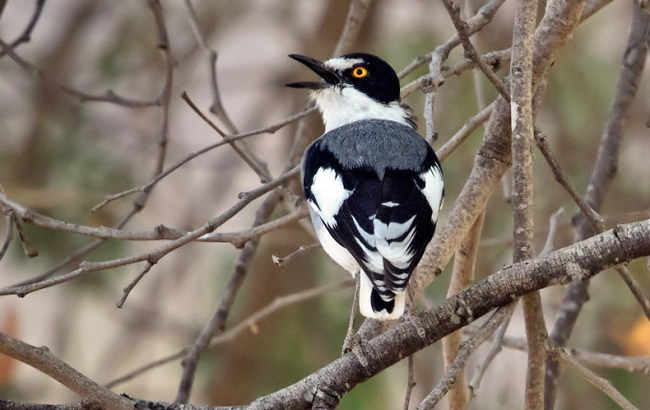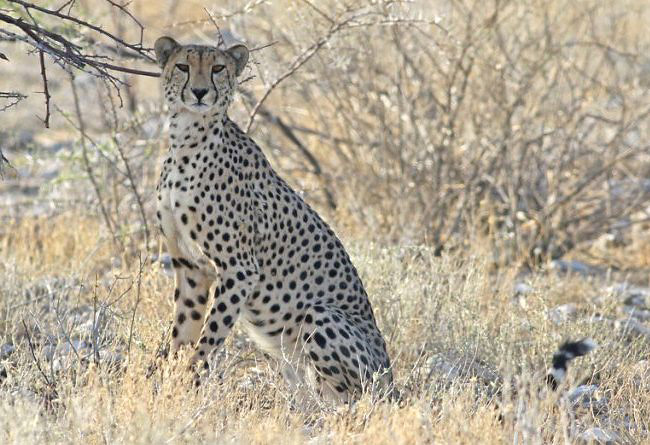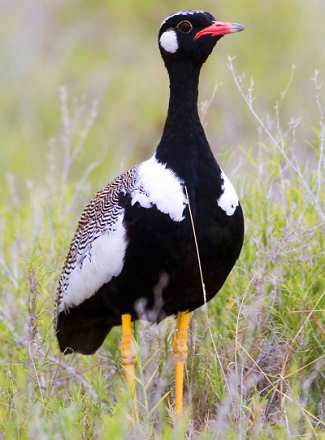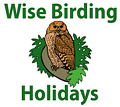

Gemsbok with one of the highest sand dunes in the world behind it, at Sossusvlei - a fine image by Coke & Som Smith.
- The single endemic bird, Dune Lark, and over 100 of the 150 or so species endemic to the southern third of Africa including African Oystercatcher, Hartlaub's Gull, Blue Crane, Monteiro's Hornbill, Ground Batis, Rockrunner and several larks and chats
- Some of Africa's and the world's other most spectacular localized birds including Slaty Egret and Wattled Crane
- And some of Africa's and the world's other most spectacular birds including Common Ostrich, flamingos, Black and Goliath Herons, Hamerkop, African Fish-eagle, Secretary Bird and Kori Bustard
- As well as many of Africa's classic mammals including Lion, Leopard, Cheetah, African Elephant, Giraffe, Hippopotamus, Black Rhinoceros, Spotted Hyaena and Gemsbok, as well as the chance of Aardvark and Aardwolf
- All in a very sparsely populated part of the world where the rugged desert landscape includes some of the highest and most beautiful sand dunes in the world

A striking Ground Batis, formerly known as White-tailed Shrike, by Lars Petersson.
- Many organized tours include at least a day at Shakawe on the Okavango River across the border in Botswana where it is possible to see birds such as African Fish-eagle (habituated birds fish next to boats), Pel's Fishing-owl, Slaty Egret, White-backed Night-heron, Long-toed Lapwing, Lesser Jacana, African Skimmer and Giant Kingfisher.
- Some organized tours to Namibia include in their set itineraries, or offer as an optional extension, a trip to Victoria Falls in Zambia, one of Our Top 50 Other Natural Wonders. There or nearby it is possible to see such birds as Black-cheeked Lovebird and Rock Pratincole.
- One of the potential highlights of visiting Namibia during September-October is a visit to a nesting colony of Southern Carmine Bee-eaters in Namibia’s lush panhandle, a narrow belt of flat floodplains and riverside woodland and scrub near the Okavango Delta in Botswana. Known as the Caprivi Strip it is by far the birdiest part of this otherwise mainly dry country, with many birds present here but not elsewhere in Namibia, but the stars are the bee-eaters; crazy diamonds in a family of diamonds, most of the bee-eaters being brightly-coloured beauties. Carmine Bee-eaters are exceptional because they look like giant shiny red swallows with emerald crowns, black masks and bills, and bright pale blue rumps. One makes a magnificent sight but imagine hundreds of these masters of the air, thousands even, sweeping and swooping to and from their nesting tunnels in the sandy banks of the Zambezi River. They make a dazzling spectacle and one such colony can usually be found near Kalizo Lodge.
- Watch out. The mammals in some private 'game reserves' have been introduced to their fenced grounds, some would say inappropriately in some cases; for example, the mammals in question may not have occurred there naturally.
Best Birds and other wildlife in Namibia
Birds
Endemics 1
Dune Lark.
Near-endemics
Namibia and Angola 16 Hartlaub’s Francolin, Ruppell’s Bustard, Monteiro’s Hornbill, Damara Red-billed Hornbill, Violet Woodhoopoe, Ruppell’s Parrot, Ground Batis (White-tailed Shrike), Carp’s Tit, Gray’s Lark, Benguela Long-billed Lark, Rockrunner, Bare-cheeked Babbler, Cunene (Meves’s) Long-tailed Starling, Herero Chat, Angola Cave-chat and Cinderella Waxbill.
Namibia, Angola and Botswana 1 Black-faced Babbler.
Namibia, Angola and South Africa 7 African Oystercatcher, Rosy-faced Lovebird, Grey-backed (Red-headed) Cisticola, Pale-winged Starling, Sickle-winged Chat, Mountain Wheatear and White-throated Canary.
Namibia, Angola, Botswana and South Africa 5 Burchell’s Courser, Short-toed Rock-thrush, Karoo Chat, Tractrac Chat and Stark’s Lark.
Namibia and South Africa 25 (A crane, a penguin and seven larks) Blue Crane, Karoo Bustard, African (Jackass) Penguin, Crowned Cormorant, Bank Cormorant, Hartlaub’s Gull, Black Harrier, Jackal Buzzard, Grey Lark, Karoo Long-billed Lark, Cape Long-billed Lark, Barlow’s (Dune) Lark, Cape Clapper Lark, Sclater’s Lark, Large-billed Lark, Karoo (Yellow-rumped) Eremomela, Namaqua Warbler, Cinnamon-breasted (Kopje) Warbler, Karoo Prinia, Layard’s Warbler, Orange River White-eye, Karoo Scrub-robin, Southern Double-collared Sunbird, Cape Weaver and Black-headed Canary.
Namibia, South Africa and Botswana 6 White-backed Mousebird, Fairy Flycatcher, Black-eared Sparrow-lark, Rufous-eared Warbler, Karoo Thrush and Sociable Weaver.
Other specialities
Slaty Egret, Wattled Crane, Racket-tailed Roller and Rufous-tailed Palm-thrush. Also a chance of Bronze-winged Courser.
Others
Common Ostrich, francolins, African Pygmy Goose, White-chinned Petrel, Lesser and Greater Flamingos, Cape Gannet,
Great White Pelican, African Darter, Black, Goliath and Rufous-bellied Herons, Hamerkop, vultures, African Fish-eagle,
Bateleur, Martial, Steppe, Tawny and Verreaux's Eagles, Secretary Bird, Pygmy Falcon, Black Crake, bustards, Spotted
Thick-knee, Blacksmith and Chestnut-banded Plovers, White-headed Lapwing, African and Lesser Jacanas, Red-necked
Phalarope (mostly Nov-Mar), Rock Pratincole, Temminck's Courser, Greater Painted-snipe, Damara Tern (mostly Nov-Mar),
African Skimmer, sandgrouse, Schalow's Turaco, owls Verreaux's Eagle-owl, Red-faced Mousebird, Giant Kingfisher,
bee-eaters including Southern Carmine (usually at nesting colonies, Sep-Oct), Madagascar, Swallow-tailed and
White-fronted, Lilac-breasted Roller, hornbills, barbets, Pririt Batis, White-crested Helmetshrike, Crimson-breasted
Gonolek, Magpie Shrike, African Paradise-flycatcher, larks, chats, Groundscraper Thrush, starlings, Red-billed and
Yellow-billed Oxpeckers, sunbirds, canaries, Scaly-fronted Weaver) and waxbills. Also a chance of Saddle-billed
Stork and African Finfoot.
Mammals
Lion, Leopard, Cheetah, African Elephant, Giraffe, Hippopotamus, Black and White Rhinoceroses, Spotted Hyaena,
Gemsbok, Burchell's and (Hartmann's) Mountain Zebras, Blue Wildebeest, African Buffalo, Chacma Baboon, Vervet Monkey, Bat-eared Fox, South African
Crested Porcupine, Spring Hare, Sable, Eland, Greater Kudu, Red Lechwe, Topi (Tsessebe), (Red) Hartebeest, (Black-faced) Impala, Springbok, Steenbok,
Klipspringer and Cape Fur Seal. Also a chance of Caracal, Brown Hyaena, Aardvark, Aardwolf, African Wild Dog, Meerkat, Honey Badger, Striped Polecat
(Bushmanland), Roan (Khaudum NP), Smith's Rock Elephant Shrew, Humpback Whale, and Bottlenose, Dusky and Heaviside's (most likely on boat trips out
of Walvis Bay) Dolphins.

Cheetah, Etosha, Namibia, by Chris Townend.
Invertebrates
Fog-drinking Beetle (Stenocara).
Plants
Welwitschia mirabilis, a strange desert plant, some specimens of which
are believed to be over a thousand years old and others which may be almost two thousand years old.
Other Natural Wonders of Namibia
Namib Desert The oldest desert on Earth runs about 1600 km (1000 miles) along the coast of Namibia and is up to 160 km (100 miles) from west to east. Some of the highest sand dunes in the world, around 300 m (1000 ft) high, can be seen at Sossusvlei and near there lies picturesque Dead Vlei with its dead Camel Thorn Trees (Acacia erioloba), and Hidden Vlei.
Best Sites for Birds and other wildlife in Namibia
- Avis Dam, near Windhoek Rockrunner.
- Daan Viljoen GR Giraffe, Gemsbok and Ground Batis.
- Sossusvlei Gemsbok, Common Ostrich and Dune Lark below some of the highest sand dunes in the world. Also a chance of Brown Hyaena and Burchell's Courser.
- Spreetshoogte Pass Pygmy Falcon, Rosy-faced Lovebird, Lilac-breasted Roller, Ground Batis, Herero Chat and Lark-like Bunting.
- Namib Desert between Spreetshoogte Pass and Walvis Bay Gemsbok, Ludwig's and Ruppell's Bustards, Dune and Gray's Larks, and Welwitschia (at Homeb). Also a chance of Burchell's Courser.
- Walvis Bay and Swakopmund, Skeleton Coast Cape Fur Seal, Lesser and Greater Flamingos, White-chinned Petrel, Cape Gannet, Great White Pelican, Chestnut-banded Plover, African Black and Eurasian (annual rarity) Oystercatchers, Red-necked Phalarope (annual rarity), Hartlaub's Gull and Damara Tern. Also a chance of Humpback Whale, Bottlenose, Dusky and Heaviside's (most likely on boat trips) Dolphins, and Jackass Penguin.
- Cape Cross A chance of Brown Hyaena at Cape Fur Seal colony.
- Spitzkoppe Gray's Lark and Herero Chat.
- Erongo Wilderness Lodge Area South African Crested Porcupine, Smith's Rock Elephant Shrew, Klipspringer, Verreaux's Eagle, Freckled Nightjar, Violet Woodhoopoe, Ground Batis and Rockrunner. Also a chance of Aardwolf.
- Erindi 'Game Reserve' A chance of Aardvark, Aardwolf, African Wild Dog, Honey Badger, Caracal, and Black and White Rhinos.
- Hoanib Valley, Damaraland (and Palmwag) A chance of Lion, Leopard, Cheetah, African Elephant (desert form), Giraffe, Black Rhinoceros, Spotted and Brown Hyaenas, and Gemsbok.
- Porcupine Camp, Kamanjab South African Crested Porcupine (at feeder at night).
- Rustig Toko Lodge A chance of Aardvark, Aardwolf, Spring Hare and Bronze-winged Courser on night drives. Also Hartlaub's Francolin, Swallow-tailed Bee-eater, Ground Batis, Crimson-breasted Gonolek, Bare-cheeked Babbler and Short-toed Rock-thrush.
- Huab Conservation Area African Elephant, Mountain Zebra, Giraffe, Gemsbok, Springbok, Steenbok, Klipspringer, Spring Hare, Hartlaub's Francolin, Verreaux's Eagle, Pygmy Falcon, Rosy-faced Lovebird, Monteiro's Hornbill, Rockrunner, Crimson-breasted Gonolek and Ground Batis.
- Hobatere GR Lion, African Elephant, Giraffe, Bat-eared Fox, Spring Hare, Gemsbok, Klipspringer, Secretary Bird, Tawny and Verreaux's Eagles, Double-banded and Namaqua Sandgrouse, Madagascar Bee-eater, Ground Batis, Rockrunner, Groundscraper Thrush and Bare-cheeked Babbler. Also a chance of Aardvark and Aardwolf.
- Etosha NP Best around Okaukuejo (in drier west where there is a floodlit water-hole), Halali (central-south, also with floodlit water-hole) and Namutoni (wetter east, also with floodlit water-hole) where Lion, Cheetah, African Elephant (the largest in Africa), Giraffe, Black Rhinoceros, Spotted Hyaena, Burchell's Zebra, Blue Wildebeest, Gemsbok, Springbok, Steenbok, Greater Kudu, Hartebeest, Impala, Common Ostrich, Secretary Bird, Kori Bustard, Blue Crane, vultures, Pygmy Falcon, Northern Black Bustard, Spotted Thick-knee, Greater Painted-snipe, Double-banded and Namaqua Sandgrouse, Violet Woodhoopoe, White-crested Helmetshrike, Ground Batis, Rufous-eared Warbler, Groundscraper Thrush and Bare-cheeked Babbler. Also a chance of Honey Badger (Halali), South African Crested Porcupine (Halali), Ludwig's Bustard, Burchell's Courser and Burchell's Sandgrouse.
- Kunene River, Ruacana Rufous-tailed Palm-thrush, Bare-cheeked Babbler and Cinderella Waxbill.
- Waterberg Plateau Verreaux's Eagle, Violet Woodhoopoe and Rockrunner. Also a chance of South African Crested Porcupine.

Northern Black Bustard in Etosha by Ian Merrill.
- Caprivi Strip
- Rundu area Black and Rufous-bellied Herons, Baillon's Crake, Greater Painted-snipe and Giant Kingfisher. Also a chance of Lesser Jacana.
- Popa Falls Rock Pratincole (most likely Aug-Feb).
- Mahango GR Hippopotamus, African Buffalo, Sable, Red Lechwe, African Fish-eagle, Goliath Heron, Wattled Crane, Slaty Egret, Giant Kingfisher, and Southern Carmine and White-fronted Bee-eaters. Also a chance of Saddle-billed Stork and Burchell's Sandgrouse.
- Ndhovu Lodge Hippopotamus, Black Heron, Slaty Egret, African Skimmer and (Southern) Carmine Bee-eater.
- Kalizo Lodge, Zambezi River Black Heron, African Pygmy Goose, White-headed Lapwing, Lesser Jacana, Greater Painted-snipe, Schalow's Turaco, Southern Carmine Bee-eater (nesting colony) and Racket-tailed Roller. Also a chance of African Finfoot.
Best Times for Birds and other wildlife in Namibia
The best time to visit for mammals is during the cooler, dry season which usually lasts from May to September, especially toward the end of this period when many of the mammals (and some birds) concentrate around remaining waters (notably in Etosha), and Southern Carmine Bee-eaters are usually busy at their nesting colonies in the Caprivi Strip. The wet season usually lasts from November to April and many birds start breeding and therefore become more active in November so this is the peak time to visit for birds. It is usually wettest from January to March.
Recommended Bird Books etc. for Namibia
Travellers' Wildlife Guides: Southern Africa by B Branch et al. Interlink Books, 2013.
Bradt Travel Guide: Southern African Wildlife by M Unwin. Bradt, 2011 (Second Edition).
Watching Wildlife: Southern Africa by M D Firestone et al. Lonely Planet, 2009 (Second Edition).
Stuarts' Field Guide to Mammals of Southern Africa by C and M Stuart. Random House Struik, 2015 (Revised Edition).
The Kingdon Field Guide to African Mammals by J Kingdon. Bloomsbury, 2015 (Second Revised Edition).
The Kingdon Pocket Guide to African Mammals by J Kingdon. Bloomsbury, 2016 (Second Edition).
SASOL Birds of Southern Africa by I Sinclair et al. C Struik, 2020 (Fifth Edition).
Birds of Africa south of the Sahara by I Sinclair and P Ryan. C Struik, 2011 (Second Edition).
Newman's Birds by Colour by K Newman. C Struik, 2011 (Third Edition).
Newman's Birds of Southern Africa by K and V Newman. C Struik, 2010 (Tenth Edition).
Roberts Bird Guide edited by H Chittenden. Africa Geographic, 2007.
Birds of Botswana by P Hancock and I Weiersbye. PUP, 2015.
Southern African Birdfinder by C Cohen and C Spottiswoode. New Holland Publishers, 2005.
Apps etc.
eGuide to Mammals of Southern Africa
The Kingdon Guide to African Mammals.
Audubon African Wildlife.
SASOL eBirds of Southern Africa.
Newman's Birds of Southern Africa.
Roberts Multimedia Birds of Southern Africa.
Where to watch birds in Africa by N Wheatley. Helm, 1995.
Don’t know which country/countries to visit in Africa? Then it may be worth considering taking a look at this book, written by this website’s author. It is many years old of course but it still provides a starting point, an overview and a guiding light to the best birds and the best places to look for them on the continent, and could save hours of searching for similar information on the internet. However, it is important to check more up-to-date sources for sites which have been opened up, sites and species which have been discovered, lodges that have been built etc. since the book was published.
Birding and Wildlife Trip Reports for Namibia
Many trip reports, some for Namibia, are posted on the websites listed here. On some of these websites some reports are independent and some are posted by tour companies who organize tours to Namibia. These tour companies and others also post their own reports on their websites, which are listed under 'Some Organized Tours to Namibia' below.
- The best website for trip reports is CloudBirders
- but these are also worth a look
- Birdtours
- Fatbirder
- Jon Hornbuckle
- Mammal Watching
Local birdd and wildlife guides in Namibia
The costs of organized tours partly reflect the quality of the tour leaders. Some leaders are certainly better than others and many companies claim their leaders are the best but even the best rely at least to some extent on the exceptional skills of the local guides they employ. If you are travelling independently, employing such local guides will greatly increase your chances of seeing the wildlife you wish to see.
Accommodation for birders in Namibia
Some Organized Tours for birds and other wildlife to Namibia
There are many tour companies who organize tours to see mammals, birds, other wildlife and other natural wonders. The cost of these tours vary considerably according to such variables as the airlines used, the number of days the tours last, the number of sites visited, the number of people in the group (an important consideration if you wish to see such wildlife as rainforest mammals and birds), the number of tour leaders, the standard of accommodation and transport, and the percentage profit the company hopes to make. Generally, where the number of days tours last and the number of sites visited are similar, the cheapest tours are those that use the cheapest airlines, accommodation and local transport, that have the largest groups with the least number of leaders, and that make the least amount of profit. The most expensive tours tend to be those which are exceptionally long, use the most expensive accommodation (ridiculously lavish in some cases, even for single nights) and which make the most profit. Some tour costs partly reflect the quality of the tour leaders. Some leaders are certainly better than others and many companies claim their leaders are the best but even the best rely at least to some extent on the exceptional skills of the local guides they employ.
While tour companies organize tours with set itineraries many also organize custom tours for individuals and private groups who instead of taking a tour with a set itinerary want to follow their own itinerary to suit their own personal tastes, whether it be mammals, birds, other wildlife, other natural wonders or even man-made attractions, or a mixture of them all. Many organized tours with set itineraries are also fast-paced and target as many species as possible, whether they are mammals, birds or other wildlife or everything, which usually leaves little time to enjoy the best sites and individual species, but on a custom tour those taking part can specify the pace and the sites and species they wish to concentrate on. Custom tours also suit people who like to travel with people they already know, rather than with a group of strangers, and people with partners with different interests. Individuals and small groups will almost certainly have to pay more than the price of an organized tour with a set itinerary but a large group of friends may be able to travel for less than the price quoted for a set tour.
Tour companies who run organized tours or can arrange custom tours to Namibia include the following.
- Birdquest
- Field Guides
- Rockjumper
- Victor Emanuel Nature Tours
- Wise Birding Holidays
- We are a small wildlife watching holiday company based in Devon (UK) specialising in birdwatching and mammal watching holidays across the world. What sets us apart from other wildlife watching companies is quite simple:
- 1 – small group sizes: (average between 4 – 8 people)
- 2 – a commitment to conservation: (donation after each tour)


